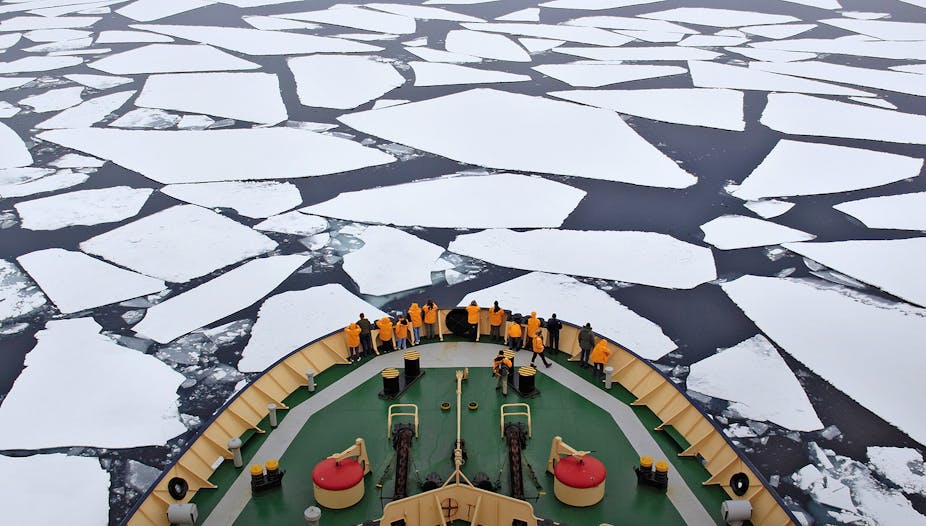Disappearing Arctic sea ice has brought new opportunities for shipping, and placed the top of the world squarely on industry and politicians’ agendas. When the bulk carrier MV Nordic Orion last week ferried 73,500 tons of coal from Vancouver, Canada to Pori, Finland, it was the first to traverse the Northwest Passage (NWP) through the Canadian Arctic Archipelago as a commercial trade route.
This northern route can be substantially shorter. The Nordic Orion cut more than 1,000 nautical miles (1,850km) off the traditional route through the Panama Canal. And without the size and displacement constraints of the canal, it was able to carry 15,000 additional tons of cargo. All this meant time and fuel saved, better utilisation of the full capacity of the ship, and reduced CO2 emissions.
Does this mean that the fabled Northwest Passage searched for by numerous valiant explorers in the past, has finally opened for business? Is this a potential challenger to established international shipping routes such as the Suez and the Panama canals?

The debate over Arctic shipping has focused more on the growing use of the Northern Sea Route (NSR) over Russia’s northern shores. China and other major Asian exporters have voiced their interest in northeastern routes that would circumvent shipping routes through regions plagued by regional conflicts, terrorists and piracy. The number of ships transiting the route and volumes of cargo carried are rising again, having declined significantly since their peak of 7m tons in 1987.
The easier ice conditions of the Eurasian Arctic route has led experts to expect Arctic shipping through the NSR to gain global significance. The extent of sea ice in the Arctic in late September 2013, a point very close to the annual minimum, shows the Canadian Arctic sea far more choked with ice than along the Russian coast, making regular shipping much more feasible.

There’s also far less emergency response infrastructure and capabilities on the North American side than along the Norwegian and Russian coasts. There are no deepwater ports along the North Slope of Alaska, for example, and only very few throughout the Canadian Archipelago. And in any case, the remoteness, harsh weather conditions, ice, winter darkness and summer fog make the North American Arctic highly risky. Even after giving notice to the Canadian Coast Guard agency NORDREG, any emergency would be a huge challenge, with Coast Guard facilities far away.
Taken together this suggests the MV Nordic Orion will most likely not be followed by many other commercial users of the Northwest Passage. Instead, it was more a demonstration of the shipping company’s technology to master ice-strewn waters. In fact the company’s own press release states that it is an “ice-class 1A ship”, the highest conventional ice-class, and “one of the only ships that can sail the route.” The harsh conditions in the Arctic demand special ship design; such ships are expensive and not available in large numbers.
Neither are the economics of using the northern routes assured. Both northeastern and northwestern routes are possible for only a few months, and are relevant only for certain commodities found in the region, such as coal, oil and gas, copper and nickel, or timber. And shipping records seem to confirm this: most Arctic shipping today and forecasted for the future is to or from Arctic destinations. Shipping that crosses the Arctic from the Atlantic to the Pacific or vice versa is of little importance.
This is likely to remain the case for the foreseeable future. For example, while 46 vessels crossed the NSR in 2012, the Suez Canal sees around 18,000 a year, and the Panama Canal 14,000. The current expansion of the Panama Canal and a possible new canal in Nicaragua could make crossing via South America cheaper for shipping companies, and thus more attractive than risky northern routes. And generally, global trade patterns are likely to develop in such a way that northern routes might not be very attractive. Rising consumer power among the growing populations of Asia, South America and India will draw shipping routes further south, for example. New shipping hubs will appear in these countries that many ships will want to call at when crossing oceans, and the Arctic routes will often no longer be shorter.
Overall, it’s worth bearing in mind the multitude of problems and hindrances to the Northwest Passage and the Northern Sea Route becoming major maritime routes, from the difficult weather, to the narrow annual window, and shifting global markets. One ship sailing the Northwest Passage is not an indication that large scale commerce is coming to Arctic waters.

